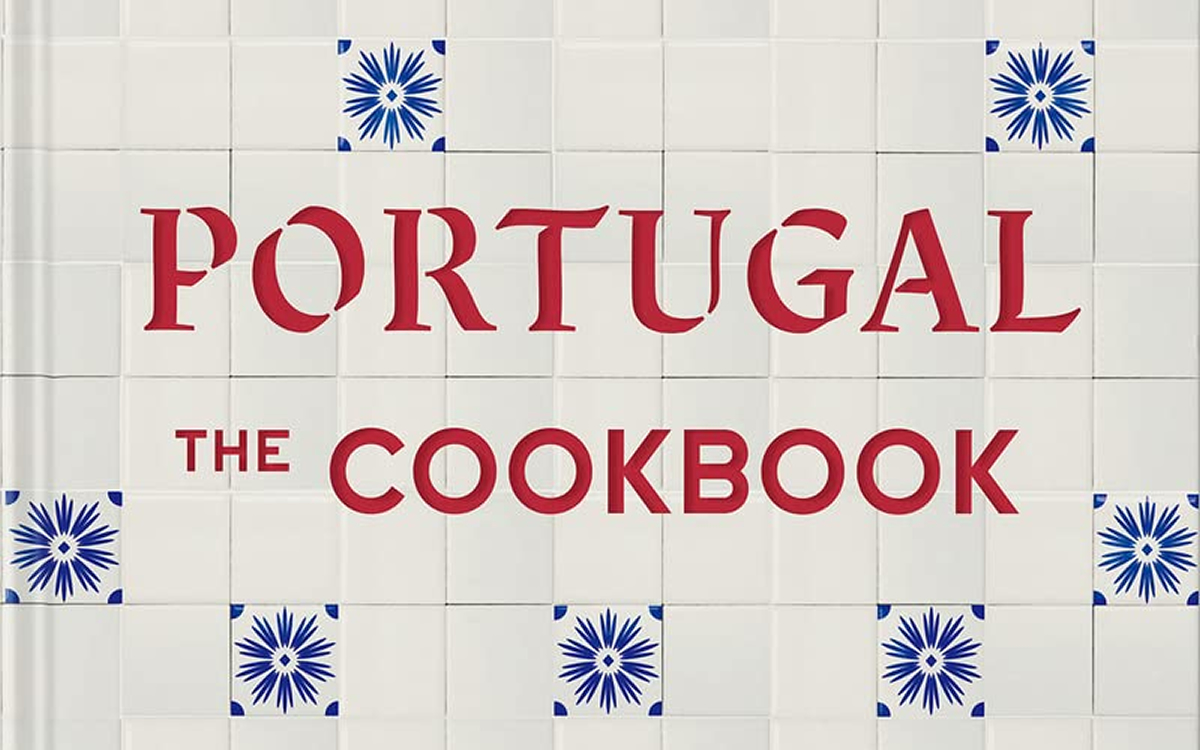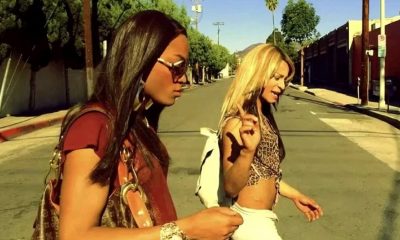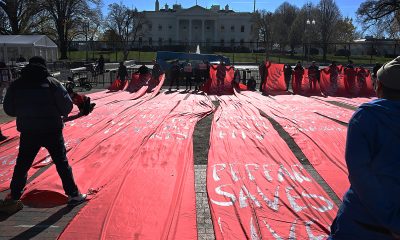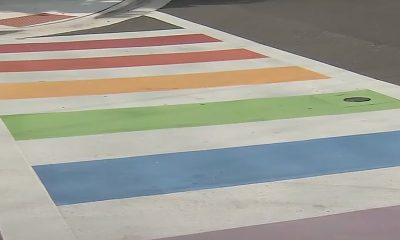Books
Celebrating Arab and Muslim heritage, art, gastronomy
Three new books open a window to influential cultures

As a college student, I hungered for Arab and Muslim representation. Prejudice against our communities was mainstream and demoralizing. Things, however, can sometimes change sooner than we expect.
Although Muslims and Arabs are still maligned, it is no longer as widespread and is often counterbalanced by allyship and, crucially, Muslim and Arab representation. From Hulu’s “Remy,” Netflix’s “Master of None,” HBO Max’s “Sort Of,” to the upcoming premiere of Disney+’s “Ms. Marvel” to Muslim characters on “Love Victor,” “Never Have I Ever,” and “Genera+ion,” Muslim characters and creators are now common. And these creators are diverse, proud, and often queer.
Mahersalah Ali is a two-time Oscar winner (one for the Black queer Best Picture winner “Moonlight”) and Riz Ahmed is the first Muslim to be nominated for Best Actor; he won an Oscar this year for a short film taking on British xenophobia, and spearheading an initiative to boost Muslim representation in Hollywood from screenwriters to actors.
From starving to satisfied, it has been quite a transformation in American culture. And it’s not only TV and film. Political representation isn’t novel anymore. I still remember when former Rep. Keith Ellison was asked on CNN to prove his loyalty by the conservative host Glenn Beck. Today, Reps. Ilhan Omar and Rashida Tlaib are progressive trailblazers. Irvine, Calif., has a Muslim mayor in Farrah Khan. Joe Biden has nominated the first Muslims to the federal judiciary, one has been confirmed and the other, civil rights lawyer Nusrat Choudhury, awaits Senate confirmation. And Biden, lest we forget, said “inshallah” (God willing) on the presidential debate stage. “We’ve made it,” I want to shout. But I know we’re still fighting for full normalization in American life.
Hence my excitement over three new books (two cookbooks and one art text) that feature Arab and Muslim heritage, art, and gastronomy.
Arab roots of Portuguese cooking
“To these new rulers [the Moors], cuisine was an art, and food a gift from God that should be consumed in moderation and shared with those in need,” writes Leandro Carreira, the author of “Portugal: The Cookbook.” It’s not surprising to learn that Arabs and Berbers shaped the evolution of Portuguese cuisine, but what’s striking is the nature of its legacy. In this cookbook of 700 recipes, half draw from the Moors.
When Moors conquered the Iberian Peninsula (Portugal and Spain) they brought with them not only warriors and administrators but architects, astronomers, poets, and, inter alia, cooks along with cookbooks, such as the Medieval “Kitab al Tabikh.”
The Moors introduced hydraulics that irrigated the farmland (along with orchards and leafy gardens) and beautified the land by planting citrus trees both for the fruit and scent. The list of crops introduced by Moors includes eggplant, artichoke, carrot, lentils, cucumber, and lettuce. The latter would later christen the residents of Lisbon, who are colloquially known as Alfachinhas (“little lettuces”). Moors popularized sour oranges, apricots, dates, melons, and watermelons; spices such as pepper and ginger; pickling of olives and nuts; sour marinade to preserve fish; rose water and orange blossom. The Moors’ vinegary salads were the precursor to gazpacho. The introduction of sugarcane later severed Portuguese colonization and fueled the slave trade, and transformed sugar from luxury to staple.
Naturally, the North African rulers brought couscous, the main consumed wheat until the late 16th century. To this day, northwestern Portuguese villagers prepare couscous using the methods and utensils introduced by Berbers 900 years ago.
The Moors cultivated hospitality and conviviality at the table along with the order in which food is served: soups followed by fish or meat and concluding with sweets. The Arabs’ cousins, the Jews played their part in shaping Portuguese cooking, too. Jews prepared their post-Sabbath meal by laying aside a slow-burning stew of meat, chickpeas, collard greens, hard-boiled eggs, and vegetables; today, the Portuguese call it Adafina. Jews introduced deep-fried vegetables and Portuguese missionaries later brought them to Japan and (voilà!) tempura.
In its history, “Portugal” evokes our interwoven humanity.
Arabiyya: Cooking as an Arab in America
The past few years have seen cookbooks with narratives of culture and personal journeys foregrounding recipes — many focused on Arab culture. “The Gaza Kitchen” by Laila el-Haddad and Maggie Schmitt and “The Palestinian Table” and “The Arabesque Table” by Reem Kassis, for example. To this list, we can add “Arabiyya: Recipes from the Life of an Arab in Diaspora” by the James Beard finalist Reem Assil.
For connoisseurs of Arab food in America, Reem is no stranger. Reem’s California, a bakery in Oakland and San Francisco, has acquired temple status for its use of California’s ingredients in the service of Arab dishes. A few years ago, the New York Times praised Reem’s as an “Arab Bakery in Oakland Full of California Love.” (The bakery was, sadly, the target of vulgar anti-Palestinian prejudice for its mural of Palestinian activist Rasmeah Odeh.)
Food was Reem’s saving grace. Facing a debilitating digestive disorder, and the wreck of familial stress, Reem left college and headed to the Bay Area live with her Arab uncle and Jewish aunt. Soothed by California’s climate, nature, and ingredients, she found mental and physical healing — and roots and purpose.
“Arabiyya” is a guide to California-based, Arab-rooted recipes alongside tales of Reem’s journey and her family’s. Her grandparents fled the Nakba — the 1948 “catastrophe” of the forced exile of roughly 750,000 Palestinians at the hands of Israeli troops — and the Naksa, the 1967 War that forced her family to decamp once more for Lebanon. The Lebanese Civil War led to one more flight to Greece, and finally, California.
Growing up American, Reem knew little of her grandmother’s resilience. After her sitty’s (colloquial Arabic for grandmother) passing, she pasted together tales from relatives of her grandmother’s determination to uphold Arab hospitality no matter where she landed. Her identity as a Palestinian was threatening both in Lebanon and America — but she walked with dignity. Arab hospitality meant that home was a safe comfort no matter the headwinds outside, and, at times, her grandmother went lengths to survive. A tale of sneaking out during a pause in fighting in Beirut became family lore: sitty couldn’t forget her lemons (who would serve fish without lemons?!) even after a rocket attack knocked her down.
Food’s healing and grounding became the thread uniting Reem with sitty. “I’ve come to realize that my grandmother, who loaded the table to its edges with tasty morsels of my favorite foods, lives through me,” Reem relates.
Reem’s journey to cook and bake as love and spontaneity opened a window to heritage — a family’s history and Arab pride. Her recipes (like the California Fattoush Salad where traditional tomatoes are swapped for oranges and citrus and fried sunchokes) overflow with love. “Arabiyya” is destined to be a classic among Arab-Americans.
Arab artists in their prime
Artists from the Arab world exhibiting in the West face a challenge: Our culture is ubiquitous in Western depictions but poorly understood; a dilemma for the artist who must inevitably “interrogate the stereotypes that spectators bring to the practice of looking at mythologized places,” in the words of critic Omar Kholeif in his review of the Abu Dhabi-born and NYC and Dubai-based Farah Al Qasimi.
Al Qasimi is one of five Arab artists featured in the new collection on “art’s next generation” entitled “Prime.” In “After Dinner 2” (2018), Al Qasimi captures the pressures of domestic life in her native UAE and the misconceptions westerners have about Arab domesticity. A mother stands behind her daughter kneeling on the couch while looking out at the window. The mother’s stance is recognizable to any child raised by an Arab mother: head tilted up and her arms stretched out — a plea for God’s mercy in the face of a stubborn child. The pink and white staging of the drapes and couch suggest the mother-daughter dispute is about marriage, the daughter having sights on another admirer. Neither the daughter’s nor the mother’s face is visible. The mother’s face overflows out of frame while the daughter’s rests behind the drapes. Al Qasimi’s photograph turns on its head the Western conception that Arab women are hidden “behind the veil;” their life is plain to see if one discards their preconceived notions and recognizes that mothers and daughters differ universally.
Gulf Arab states, soaked in oil and gas money, however, pander to Western standards. Alia Farid scrutinizes the imitation. Urbanization has upended life in the Gulf, including in the official representation of culture. Seeking to parade heritage, Gulf states are crafting historical narratives that embody less the realization of culture and more a contrived display that weaves together disparate artifacts, as Farid displays in a mock-museum exhibition titled “Vault” (2019). These exhibitions stand as staid advertisements — a defensive declaration: “We, too, have culture!” — placing together all manners of ancient and modern objects without telling a coherent story or inspiring new creativity.
In a juxtaposition, “At the Time of the Ebb” (2019) is a video installation documenting the celebration of Nowruz Sayadeen (Fisherman’s New Year) on the island of Qeshm, Iran. “We are brought close to culture at its grassroots level — the suggestion being that cultural life is built in communities as opposed to something to represent within the entanglements of a global museum industry, one that willfully neglects the culture it seeks to validate,” observe critics Hana Noorali and Lynton Talbot.
The Middle East’s wars and rivalries inform the work of Lebanese artist Rayyane Tabet, who works in Beirut and San Francisco. “Steel Rings” (2013) is a recreation of the Trans-Arabian Pipeline that was abandoned due to political upheaval but not before hundreds of miles of pipes were laid (and remain) underground. In Tabet’s exhibition, steel rings laid on the floor stand in for the pipeline’s route with engravings on the rings marking the locations passed underneath. The uncompleted pipeline is the only material project to exist between five regional nations. It is a sad statement on the region’s divisions that the only thing crossing that many borders is abandoned and buried steel. Humanization of the region’s troubles comes into relief in “Cyprus” (2015). The installation consists of a 1,800-pound wooden boat suspended from the ceiling. The boat was deployed by the artist’s father to flee Lebanon’s civil war but was unable to complete the journey to the neighboring island. Years later, the family found it on the coastline. Suspended in midair, solitary, the boat speaks to the anguish burdening people in the face of conflict — a hardship that is often insurmountable, like the boat drawback by the current. “Cyprus” centers our thoughts beyond the headlines — obscuring the human toil — and toward people struggling in their wake.
It is refreshing to see Arab artists creating thought-provoking art on their own terms. And so, the wheels of American life roll on as we crave our hearts on its road.
The Blade may receive commissions from qualifying purchases made via this post.

This past year, you’ve often had to make do.
Saving money here, resources there, being inventive and innovative. It’s a talent you’ve honed, but isn’t it time to have the best? Yep, so grab these Ten Best of 2025 books for your new year pleasures.
Nonfiction
Health care is on everyone’s mind now, and “A Living: Working-Class Americans Talk to Their Doctor” by Michael D. Stein, M.D. (Melville House, $26.99) lets you peek into health care from the point of view of a doctor who treats “front-line workers” and those who experience poverty and homelessness. It’s shocking, an eye-opening book, a skinny, quick-to-read one that needs to be read now.
If you’ve been doing eldercare or caring for any loved one, then “How to Lose Your Mother: A Daughter’s Memoir” by Molly Jong-Fast (Viking, $28) needs to be in your plans for the coming year. It’s a memoir, but also a biography of Jong-Fast’s mother, Erica Jong, and the story of love, illness, and living through the chaos of serious disease with humor and grace. You’ll like this book especially if you were a fan of the author’s late mother.
Another memoir you can’t miss this year is “Between the Devil and the Deep Blue Sea: A Veteran’s Memoir” by Khadijah Queen (Legacy Lit, $30.00). It’s the story of one woman’s determination to get out of poverty and get an education, and to keep her head above water while she goes below water by joining the U.S. Navy. This is a story that will keep you glued to your seat, all the way through.
Self-improvement is something you might think about tackling in the new year, and “Replaceable You: Adventures in Human Anatomy” by Mary Roach (W.W. Norton & Company, $28.99) is a lighthearted – yet real and informative – look at the things inside and outside your body that can be replaced or changed. New nose job? Transplant, new dental work? Learn how you can become the Bionic Person in real life, and laugh while you’re doing it.
The science lover inside you will want to read “The Grave Robber: The Biggest Stolen Artifacts Case in FBI History and the Bureau’s Quest to Set Things Right” by Tim Carpenter (Harper Horizon, $29.99). A history lover will also want it, as will anyone with a craving for true crime, memoir, FBI procedural books, and travel books. It’s the story of a man who spent his life stealing objects from graves around the world, and an FBI agent’s obsession with securing the objects and returning them. It’s a fascinating read, with just a little bit of gruesome thrown in for fun.
Fiction
Speaking of a little bit of scariness, “Don’t Forget Me, Little Bessie” by James Lee Burke (Atlantic Monthly Press, $28) is the story of a girl named Bessie and her involvement with a cloven-hooved being who dogs her all her life. Set in still-wild south Texas, it’s a little bit western, part paranormal, and completely full of enjoyment.
“Evensong” by Stewart O’Nan (Atlantic Monthly Press, $28) is a layered novel of women’s friendships as they age together and support one another. The characters are warm and funny, there are a few times when your heart will sit in your throat, and you won’t be sorry you read it. It’s just plain irresistible.
If you need a dark tale for what’s left of a dark winter season, then “One of Us” by Dan Chaon (Henry Holt, $28), it it. It’s the story of twins who become orphaned when their Mama dies, ending up with a man who owns a traveling freak show, and who promises to care for them. But they can’t ever forget that a nefarious con man is looking for them; those kids can talk to one another without saying a word, and he’s going to make lots of money off them. This is a sharp, clever novel that fans of the “circus” genre shouldn’t miss.
“When the Harvest Comes” by Denne Michele Norris (Random House, $28) is a wonderful romance, a boy-meets-boy with a little spice and a lot of strife. Davis loves Everett but as their wedding day draws near, doubts begin to creep in. There’s homophobia on both sides of their families, and no small amount of racism. Beware that there’s some light explicitness in this book, but if you love a good love story, you’ll love this.
Another layered tale you’ll enjoy is “The Elements” by John Boyne (Henry Holt, $29.99), a twisty bunch of short stories that connect in a series of arcs that begin on an island near Dublin. It’s about love, death, revenge, and horror, a little like The Twilight Zone, but without the paranormal. You won’t want to put down, so be warned.
If you need more ideas, head to your local library or bookstore and ask the staff there for their favorite reads of 2025. They’ll fill your book bag and your new year with goodness.
Season’s readings!
The Blade may receive commissions from qualifying purchases made via this post.
Books
This gay author sees dead people

‘Are You There Spirit? It’s Me, Travis’
By Travis Holp
c.2025, Spiegel and Grau
$28/240 pages
Your dad sent you a penny the other day, minted in his birth year.
They say pennies from heaven are a sign of some sort, and that makes sense: You’ve been thinking about him a lot lately. Some might scoff, but the idea that a lost loved one is trying to tell you he’s OK is comforting. So read the new book, “Are You There, Spirit? It’s Me, Travis” by Travis Holp, and keep your eyes open.

Ever since he was a young boy growing up just outside Dayton, Ohio, Travis Holp wanted to be a writer. He also wanted to say that he was gay but his conservative parents believed his gayness was some sort of phase. That, and bullying made him hide who he was.
He also had to hide his nascent ability to communicate with people who had died, through an entity he calls “Spirit.” Eventually, though it left him with psychological scars and a drinking problem he’s since overcome, Holp was finally able to talk about his gayness and reveal his otherworldly ability.
Getting some people to believe that he speaks to the dead is still a tall order. Spirit helps naysayers, as well as Holp himself.
Spirit, he says, isn’t a person or an essence; Spirit is love. Spirit is a conduit of healing and energy, speaking through Holp in symbolic messages, feelings, and through synchronistic events. For example, Holp says coincidences are not coincidental; they’re ways for loved ones to convey messages of healing and energy.
To tap into your own healing Spirit, Holp says to trust yourself when you think you’ve received a healing message. Ignore your ego, but listen to your inner voice. Remember that Spirit won’t work on any fixed timeline, and its only purpose is to exist.
And keep in mind that “anything is possible because you are an unlimited being.”
You’re going to want very much to like “Are You There, Spirit? It’s Me, Travis.” The cover photo of author Travis Holp will make you smile. Alas, what you’ll find in here is hard to read, not due to content but for lack of focus.
What’s inside this book is scattered and repetitious. Love, energy, healing, faith, and fear are words that are used often – so often, in fact, that many pages feel like they’ve been recycled, or like you’ve entered a time warp that moves you backward, page-wise. Yes, there are uplifting accounts of readings that Holp has done with clients here, and they’re exciting but there are too few of them. When you find them, you’ll love them. They may make you cry. They’re exactly what you need, if you grieve. Just not enough.
This isn’t a terrible book, but its audience might be narrow. It absolutely needs more stories, less sentiment; more tales, less transcendence and if that’s your aim, go elsewhere. But if your soul cries for comfort after loss, “Are You There, Spirit? It’s Me, Travis” might still make sense.
The Blade may receive commissions from qualifying purchases made via this post.
Books
‘Dogs of Venice’ looks at love lost and rediscovered
A solo holiday trip to Italy takes unexpected turn

‘The Dogs of Venice’
By Steven Crowley
c.2025, G.P. Putnam & Sons
$20/65 pages
One person.
Two, 12, 20, you can still feel alone in a crowded room if it’s a place you don’t want to be. People say, though, that that’s no way to do the holidays; you’re supposed to Make Merry, even when your heart’s not in it. You’re supposed to feel happy, no matter what – even when, as in “The Dogs of Venice” by Steven Rowley, the Christmas tinsel seems tarnished.

Right up until the plane door closed, Paul held hope that Darren would decide to come on the vacation they’d planned for and saved for, for months.
Alas, Darren was a no-show, which was not really a surprise. Three weeks before the departure, he’d announced that their marriage wasn’t working for him anymore, and that he wanted a divorce. Paul had said he was going on the vacation anyhow. Why waste a perfectly good flight, or an already-booked B&B? He was going to Venice.
Darren just rolled his eyes.
Was that a metaphor for their entire marriage? Darren had always accused Paul of wanting too much. He indicated now that he felt stifled. Still, Darren’s unhappiness hit Paul broadside and so there was Paul, alone in a romantic Italian city, fighting with an espresso machine in a loft owned by someone who looked like a frozen-food spokeswoman.
He couldn’t speak or understand Italian very well. He didn’t know his way around, and he got lost often. But he felt anchored by a dog.
The dog – he liked to call it his dog – was a random stray, like so many others wandering around Venice unleashed, but this dog’s confidence and insouciant manner inspired Paul. If a dog could be like that, well, why couldn’t he?
He knew he wasn’t unlovable but solo holidays stunk and he hated his situation. Maybe the dog had a lesson to teach him: could you live a wonderful life without someone to watch out for, pet, and care for you?
Pick up “The Dogs of Venice,” and you might think to yourself that it won’t take long to read. At under 100 pages, you’d be right – which just gives you time to turn around and read it again. Because you’ll want to.
In the same way that you poke your tongue at a sore tooth, author Steven Rowley makes you want to remember what it’s like to be the victim of a dead romance. You can do it here safely because you simply know that Paul is too nice for it to last too long. No spoilers, though, except to say that this novel is about love – gone, resurrected, misdirected – and it unfolds in exactly the way you hope it will. All in a neat evening’s worth of reading. Perfect.
One thing to note: the Christmas setting is incidental and could just as well be any season, which means that this book is timely, no matter when you want it. So grab “The Dogs of Venice,” enjoy it twice with your book group, with your love, or read it alone.
The Blade may receive commissions from qualifying purchases made via this post.




















